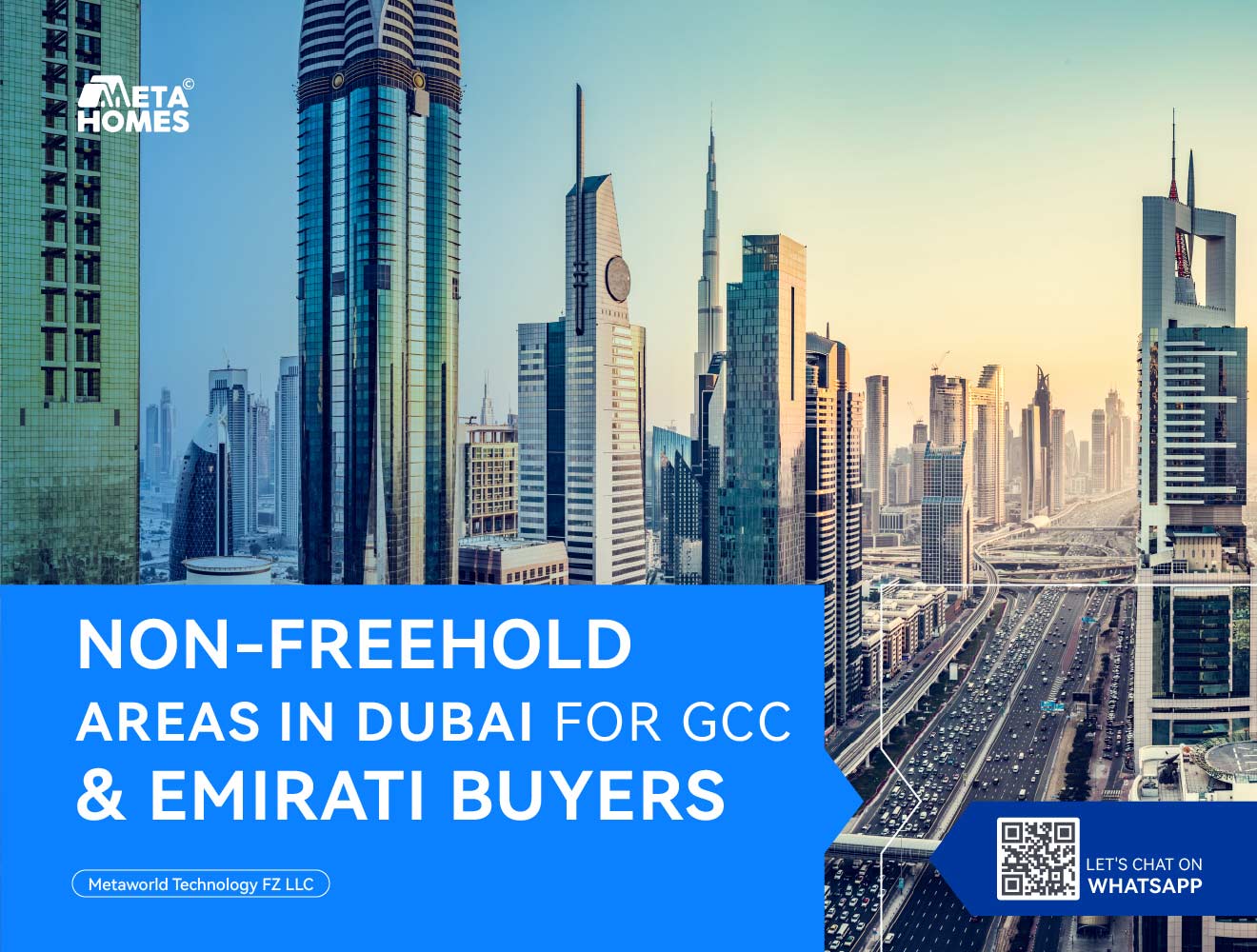
When it comes to buying property in Dubai, you’ll often hear two terms tossed around — freehold and non-freehold. Most expats and foreign investors are familiar with freehold areas, which allow full property ownership rights. But what about non-freehold areas? These lesser-known zones are exclusive to Emirati buyers and GCC nationals and have a lot to offer, especially for families looking to settle down in well-established communities with rich culture, space, and privacy.
What’s the Difference Between Freehold and Non-Freehold in Dubai?
Let’s start with the basics.
Freehold areas in the UAE are those where anyone — regardless of nationality — can purchase a property and fully own the land and the unit. Dubai introduced freehold areas in 2002 to lure foreign investment, and today, markets like freehold areas UAE include Dubai Marina, JLT, Downtown Dubai, and Dubai Hills Estate. Foreigners buy apartments and villas here with 100% title deeds.
On the other hand, non-freehold areas (sometimes called leasehold or restricted‑title zones) are neighborhoods where only UAE nationals and GCC citizens (such as those from Saudi Arabia, Kuwait, Bahrain, Qatar, and Oman) can buy and own property. Here, ownership is still full and indefinite—but only for Emiratis and citizens of GCC countries. Expatriates may live in these areas under rental contracts, but cannot hold title deeds.
Another nuance is usufruct: a long‑term lease (up to 99 years) that grants many rights of ownership without holding the freehold title. In practice, non‑freehold areas often operate under similar principles, with Emirati and GCC buyers free to sell, lease, or inherit their homes as they wish.
PS: If you’re an Emirati or a GCC national looking for a long-term investment or a family home, non-freehold areas give you access to some of the most peaceful and well-connected parts of Dubai.
Comparing Non‑Freehold with Freehold Areas
| Feature | Freehold Areas UAE | Non‑Freehold Areas in Dubai |
| Ownership Eligibility | Open to all nationalities | Only UAE & GCC citizens |
| Property Types | High‑rise apartments, villas in gated communities | Villas, townhouses, low‑rise blocks |
| Price per sq. ft. | Often higher (new developments) | Generally lower (mature areas) |
| Community Vibe | Modern, fast‑growing | Established, traditional |
| Investment Returns | Potentially higher volatility | More stable, steady appreciation |
| Rental Demand | High among expats | High for family rentals |
Why Non-Freehold Areas?
There’s a misconception that only freehold areas are worth buying in. But the reality is quite different. Non-freehold areas in Dubai often boast:
- Prime central locations
- Large plot sizes
- Low population density
- Proximity to schools, beaches, malls, and parks
- Strong community culture
- Easy access to main roads and business hubs
They’re also more affordable per square foot compared to high-rise developments in freehold districts like Downtown or Dubai Marina.
How to Know If a Community Is Freehold or Non-Freehold
Not all communities are clearly marked as “freehold” or “non-freehold” online. So, how do you know?
The easiest way is to check the Dubai Land Department (DLD) portal or talk to a trusted real estate agent. You can also ask the developer or property consultant for confirmation on ownership eligibility.
- Some larger neighborhoods may even have a mix of both — where the master community is non-freehold, but a small enclave within it is freehold.
Top Non-Freehold Areas in Dubai for Emiratis and GCC Nationals
Let’s take a look at some of the most popular and practical non-freehold areas in Dubai.
1. Jumeirah (1, 2, 3)
Jumeirah is Dubai’s original beachfront community, stretching along the Gulf coast just south of the city’s historic creek. It’s divided into three sub‑districts—Jumeirah 1 closest to the old town, Jumeirah 2 in the middle, and Jumeirah 3 to the west—and each has its own appeal. It’s home to stunning villas, beautiful beaches, boutique cafes, and landmarks like the Jumeirah Mosque and Burj Al Arab.
Schools & Healthcare
Jumeirah is home to top international schools—Dubai English Speaking College, Safa Community School, GEMS Wellington Academy—and medical centers like Medcare and Aster Clinics. This makes it a favorite for families wanting high‑quality education and healthcare within minutes of home.
Transport & Connectivity
Sheikh Zayed Road (E11) runs parallel to Jumeirah Beach Road, providing a direct link to Downtown Dubai (15–20 minutes by car) and beyond to Abu Dhabi. Public buses ply Beach Road and Al Wasl Road; the nearest metro station is Dubai Internet City, a 10‑minute drive inland.
Property Types & Prices
Villas here range from classic 3‑4 bedroom homes (≈AED 20–30 million) to ultra‑luxury 6‑7 bedroom mansions on the beach (AED 35–60 million+). A handful of low‑rise apartment blocks offer 2‑3 bedroom flats from AED 5–8 million. Because Jumeirah is small‑scale and well‑established, resale stock is limited—so good homes command premium prices and tend to appreciate steadily over time.
Why Emiratis Love It:
- Close to the sea and city
- High-end lifestyle with privacy
- Access to top schools and clinics
- Elegant villas from 3 to 7 bedrooms
This area is deeply rooted in Emirati history and continues to be a top choice for families.
2. Umm Suqeim (1, 2, 3)
Right next to Jumeirah is Umm Suqeim, another well-loved non-freehold area with family-friendly vibes. It’s home to Kite Beach, luxury villas, and some of the best schools in Dubai. It’s often thought of as “Jumeirah’s little sister,” offering a slightly quieter, more community‑focused vibe.
Schools & Healthcare
Families send kids to Emirates International School (Umm Suqeim campus) and Elite English School. Clinics like Aster and Primecare are scattered throughout the sub‑communities, ensuring quick access to routine and specialist medical services.
Transport & Connectivity
Umm Suqeim Road links directly to Sheikh Zayed Road, making it 10–15 minutes to Business Bay or Dubai Marina. Public transport includes several bus lines; the nearest metro is Dubai Marina (or Mall of the Emirates), both a short drive away.
Property Types & Prices
– Beach‑front Villas (Umm Suqeim 1 & 2): 5–7 bedrooms, AED 25–40 million.
– Garden‑style Villas & Twin Houses (Umm Suqeim 3): 4–6 bedrooms, AED 15–25 million.
– Mid‑rise Apartments (Madina Jumeirah Living): 2–4 bedrooms, AED 7–12 million.
Key Highlights:
- Great balance between old and new Dubai
- 10 to 15 minutes from Downtown and Dubai Marina
- Spacious villas, pet-friendly streets
- Attracts both locals and long-term expat tenants
3. Al Barsha
Al Barsha sits just off Sheikh Zayed Road, midway between the old city and newer freehold districts. It’s grown into a fully self‑sufficient hub, blending villas, apartments, retail, education, and leisure.
Here you’ll find everything under one roof: Mall of the Emirates (with Ski Dubai), dozens of cafés and restaurants, and community parks like Al Barsha Pond Park. Weekend markets, fitness studios, and boutique salons add to the lively neighborhood feel. While Al Barsha South has introduced freehold properties for foreigners, the main Al Barsha 1 and 2 areas remain predominantly for GCC and Emirati buyers.
Schools & Healthcare
International schools (Al Mawakeb, Gems Metropole) and nurseries dot the district. Clinics such as Mediclinic and HealthPlus serve families, while Dubai American Academy is a short drive away.
Transport & Connectivity
Three metro stations—Insurance Market, Mashreq, and Mall of the Emirates—bring freehold‑style accessibility to this non‑freehold area. Buses run along Sheikh Zayed Road and Hessa Street, and you’re just 15 minutes from both airport terminals.
Property Types & Prices
– Villas & Townhouses: 4–6 bedrooms on 500–800 sqm plots, AED 10–18 million.
– Apartments: 1–3 bedrooms in mid‑rise buildings, AED 1.2–3 million.
– Residential Plots: Rare but occasionally available for custom villa builds, AED 4–8 million per 500 sqm.
What Makes It Special:
- Close to Mall of the Emirates and major highways
- Spacious villas with private gardens
- Family-oriented, near schools like Al Mawakeb
- Option to buy residential plots and build custom homes
- Rental Yields: Apartments average 6–7%; villas 4–5%.
4. Mirdif
Mirdif is known for its peaceful environment and villa-style living. It’s one of the few areas where many residents have lived for decades, either as tenants or owners.
It is made up of tree-lined lanes, private gardens, and local souks create a “village within the city” feel. Mirdif City Centre brings cinema, bowling, and family‑friendly dining. Al Mushrif National Park next door adds huge green space for barbecues, bike rides, and picnics.
Schools & Healthcare
Repton School Dubai (Mirdif branch), GEMS Scottish School, and short‑distance nurseries serve school‑age families. Mediclinic and Moorfields Eye Hospital cater to both general and specialist healthcare needs.
Transport & Connectivity
Major roads—Ras Al Khor Road and Emirates Road—link Mirdif to Downtown Dubai (20 minutes) and Sharjah (15 minutes). Buses crisscross the area; the nearest metro is Centrepoint on the Green Line, a quick taxi ride away.
Property Types & Prices
– Villas: 3–6 bedrooms on 400–700 sqm plots, AED 6–12 million.
– Townhouses: 3–4 bedrooms in gated communities, AED 3–6 million.
– Apartments: 1–3 bedrooms in low‑rise blocks, AED 900,000–2 million.
Perks of Buying in Mirdif:
- Villas with large gardens and outdoor space
- Family parks and community centers
- Pet-friendly and walkable
- Proximity to Mushrif Park
- Affordability: Lower entry prices than coastal communities.
- Steady Growth: Less volatile market—ideal for mid‑term investors seeking stability.
Mirdif feels like a “homegrown” neighborhood, offering great community vibes and privacy.
5. Al Warqaa
A quiet yet growing neighborhood, Al Warqaa is divided into five zones and has a mix of apartments and villas. It’s well-loved by locals for its affordability and convenience. It’s a working-class neighborhood evolving into a family haven. Local malls, neighbourhood supermarkets, and dozens of F&B outlets pepper the area. Two dedicated parks (Al Warqaa Park and Nad Al Hamar Park) offer play areas, jogging tracks, and shaded seating.
Schools & Healthcare
Dubai International Academy and several reputable nurseries cater to educational needs. Clinics like Aster and Emirates Hospital Clinic ensure medical care is never far.
Transport & Connectivity
Emirates Road (E611) runs along Al Warqaa’s eastern edge, linking you to Dubai Festival City (10 minutes) and Expo City (15 minutes). Buses serve all sub‑zones; the upcoming Dubai Metro Route 2021 extension will add two new stations.
Property Types & Prices
– Villas: 3–6 bedrooms on 350–650 sqm, AED 3–7 million.
– Apartments: 1–3 bedrooms, AED 500,000–1.5 million.
More Non-Freehold Areas in Dubai
In addition to the communities above, there are over 60 other non-freehold zones in Dubai. Here’s a quick list of some of the more notable ones:
- Satwa
- Oud Metha
- Al Wasl
- Al Safa
- Al Manara
- Al Twar
- Al Karama
- Nad Al Sheba
- Hor Al Anz
- Al Mamzar
- Port Saeed
- Al Qusais
- Muhaisnah
- Al Khawaneej
- Trade Centre 1 & 2
- Al Awir
Many of these neighborhoods are close to central business districts and are popular among Emirati buyers in Dubai looking for both residential and commercial investments.
Key Benefits for GCC and Emirati Property Buyers
Here’s why non-freehold areas make a lot of sense for locals and GCC nationals:
- Cultural Familiarity: These areas reflect traditional Emirati architecture and lifestyle.
- Privacy and Space: Properties are often larger with spacious layouts.
- Community Integration: Schools, mosques, clinics, and local businesses are tailored to local needs.
- Long-Term Investment: The value of land in these areas appreciates steadily over time.
- Customization: Many plots are available for building custom homes.
FAQS
Q1. Can GCC nationals buy in freehold areas too?
Yes—GCC citizens enjoy the same rights as any foreign national in freehold areas in the UAE, so you have full access to both freehold and non‑freehold zones.
Q2. How do I check if a property is in a non‑freehold zone?
Consult the DLD’s online map or ask your agent to verify the title deed status. Developers also list ownership terms in their brochures.
Q3. What happens if a non‑GCC national lives in a non‑freehold area?
Expats can rent or lease properties under tenancy agreements. They may not obtain the title deed but can sign long‑term leases (up to 99 years) in certain cases.
Q4. Are mortgages available for non‑freehold purchases?
Yes—most UAE and GCC banks extend home loans to qualifying GCC nationals, often with competitive interest rates and up to 25‑year terms.
Q5. Do non‑freehold properties appreciate as well as freehold?
Historically, mature communities have offered steadier, moderate growth. You may miss out on the explosive gains of a new freehold development, but you also avoid high volatility.
Q6. Where can I find leasehold properties in Dubai?
Yes, though less common. Areas like Dubai Silicon Oasis and Green Community offer leasehold options, where you lease the property for a fixed number of years (usually 10–99).
Q7. Can Emiratis buy in freehold areas too?
Absolutely! Emirati and GCC nationals can buy in both freehold areas in the UAE and non-freehold zones. This gives them a wide range of options across Dubai.
Conclusion
Dubai’s non-freehold communities are some of the most livable, culturally rich, and strategically located areas in the city. They offer plenty of privacy, larger spaces, and excellent infrastructure. If you’re a GCC national or Emirati buyer, these neighborhoods are tailor-made for your lifestyle and long-term investment plans.
While the spotlight often shines on skyscrapers and new developments in freehold zones, non-freehold areas hold their own charm, offering a slice of traditional Dubai with modern amenities and deep community roots.
Whether you’re planning to build your dream villa, invest in a rental property, or simply find a comfortable family home, non-freehold Dubai has some of the best options out there.
Looking to explore property options in a non-freehold area?
It’s always a good idea to consult a licensed real estate agent and verify the latest ownership rules with the Dubai Land Department (DLD) before making a decision.



Leave a Reply